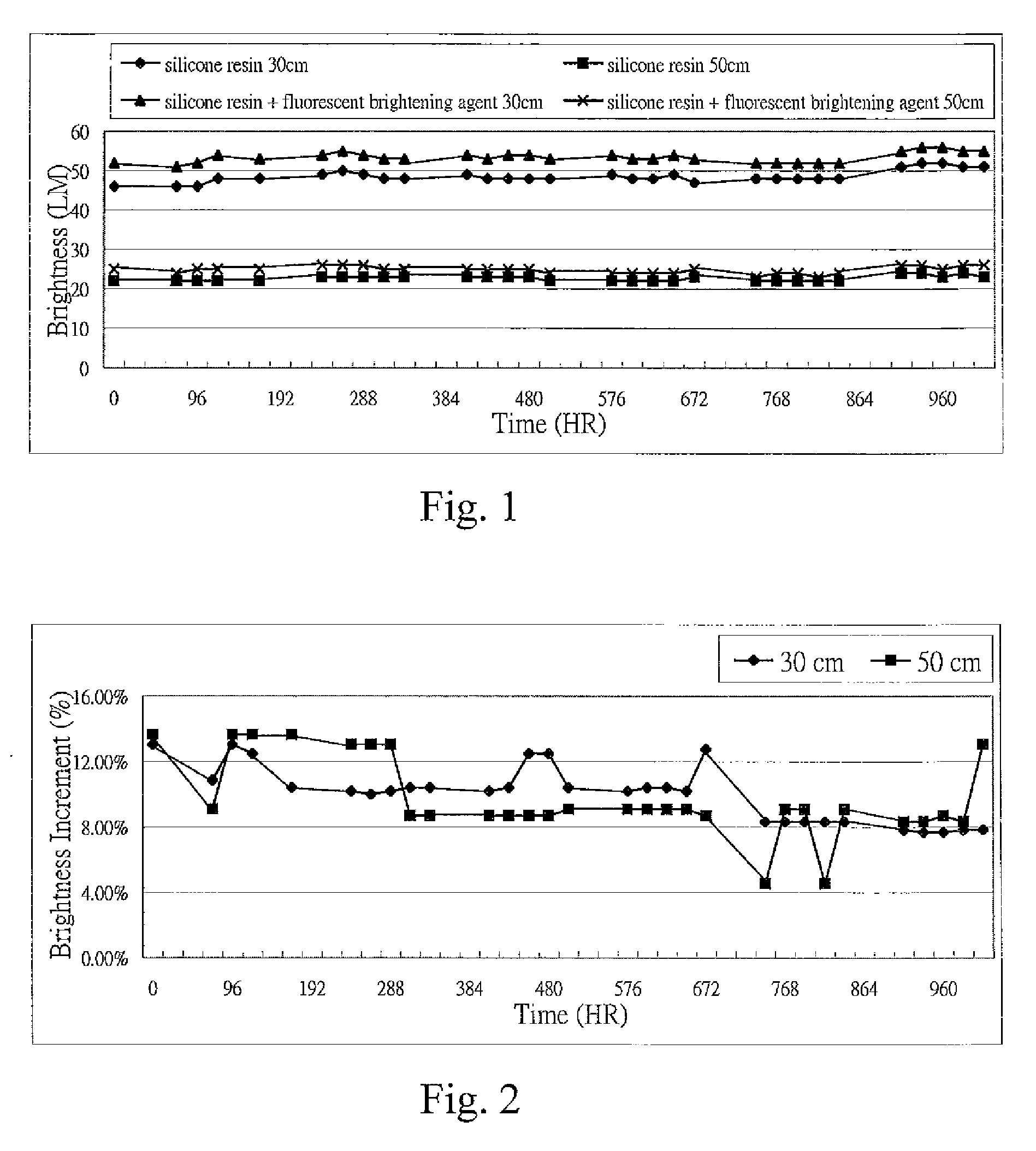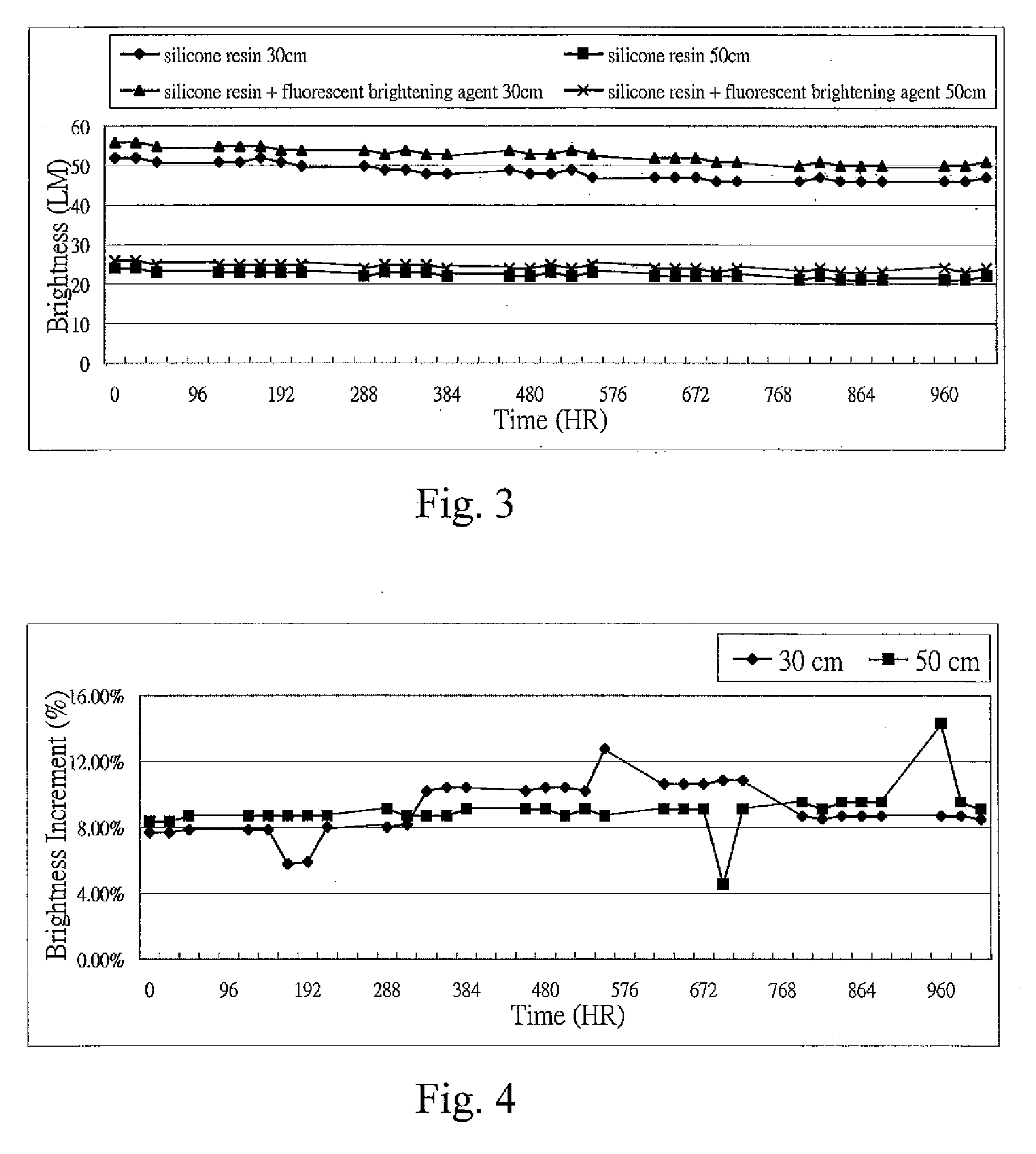Light-enhanced element
a technology of light-enhanced elements and elements, applied in the field of transparent elements, can solve the problems of color spots (such as black or yellow spots), halo phenomena, and brightnesses of conventional leds with inorganic phosphors that are usually not enough for illumination systems, and achieve the effect of increasing the brightness of light-emitting devices or panel display devices
- Summary
- Abstract
- Description
- Claims
- Application Information
AI Technical Summary
Benefits of technology
Problems solved by technology
Method used
Image
Examples
example 1
[0064]A GaN LED is die bonded and wire bonded to a PCB. 0.5% by weight of stilbene fluorescent brightening solution is prepared by dissolving stilbene used as a fluorescent brightening agent in acetone. Then, the stilbene-resin mixture is prepared by mechanically mixing 98.0% by weight of silicone resin with 2% by weight of 0.5% stilbene fluorescent brightening solution. Subsequently, the light-enhanced LED device is obtained by encapsulating the GaN LED chip with the fluorescent brightening agent-silicone resin mixture and dried. The stilbene structure is shown as following:
[0065]In addition, a conventional LED device is obtained by encapsulating a GaN LED chip with pure silicone resin and dried.
Brightness Test
[0066]The light-enhanced LED devive, sealed with a transparent encapsulation layer which is made of stilbene-silicone resin mixture, emits a blue light with a wavelength of about 465 nm when subjected to a voltage of 3.6 V, and the blue light emitted outward excites the stilb...
example 2
[0068]The light-enhanced LED device is fabricated by the same method as in EXAMPLE 1 except that benzooxazole is used as a fluorescent brightening agent instead of stilbene. The conventional LED device fabricated in EXAMPLE 1 is used. The benzooxazole structure is shown as following:
Brightness Test
[0069]By using the same method for measuring the brightness as in EXAMPLE 1, the brightness (LM) of the blue light, emitted from GaN LED chip, after passing through a transparent encapsulation layer made of benzooxazole-silicone resin mixture and undergoing wavelength conversion is measured by Illuminance Meter at the height of 30 cm, and 50 cm every 24 hours, respectively, until the total measured time reaches a setting value of 960 hours. The measurement results are shown in FIG. 3. Likewise, the brightness (LM) of the blue light with a wavelength of about 465 nm, emitted from GaN LED chip, after passing through a transparent encapsulation layer made of pure silicone resin is measured by...
example 3
[0071]The light-enhanced LED device is fabricated by the same method as in EXAMPLE 1 except that 9-oxo-xanthene is used as a fluorescent brightening agent instead of stilbene. The conventional LED device fabricated in EXAMPLE 1 is used. The 9-oxo-xanthene structure is shown as following:
Brightness Test
[0072]By using the same method for measuring the brightness as in EXAMPLE 1, the brightness (LM) of the blue light, emitted from GaN LED chip, after passing through a transparent encapsulation layer made of 9-oxo-xanthene-silicone resin mixture and undergoing wavelength conversion is measured by Illuminance Meter at the height of 30 cm, and 50 cm every 24 hours, respectively, until the total measured time reaches a setting value of 960 hours. The measurement results are shown in FIG. 5. Likewise, the brightness (LM) of the blue light with a wavelength of about 465 nm, emitted from GaN LED chip, after passing through a transparent encapsulation layer made of pure silicone resin is measu...
PUM
 Login to View More
Login to View More Abstract
Description
Claims
Application Information
 Login to View More
Login to View More - R&D
- Intellectual Property
- Life Sciences
- Materials
- Tech Scout
- Unparalleled Data Quality
- Higher Quality Content
- 60% Fewer Hallucinations
Browse by: Latest US Patents, China's latest patents, Technical Efficacy Thesaurus, Application Domain, Technology Topic, Popular Technical Reports.
© 2025 PatSnap. All rights reserved.Legal|Privacy policy|Modern Slavery Act Transparency Statement|Sitemap|About US| Contact US: help@patsnap.com



